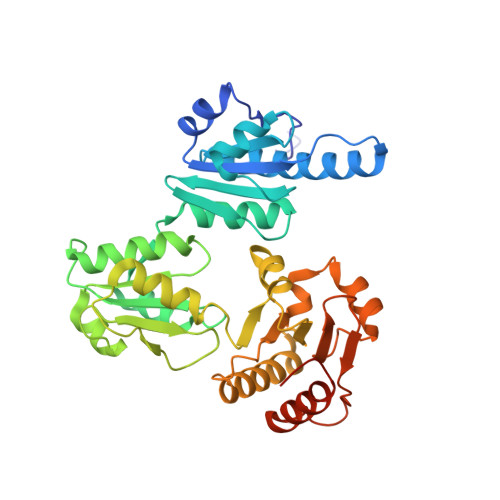Glycosylation of skeletal calsequestrin: implications for its function.
Sanchez, E.J., Lewis, K.M., Munske, G.R., Nissen, M.S., Kang, C.(2012) J Biol Chem 287: 3042-3050
- PubMed: 22170046
- DOI: https://doi.org/10.1074/jbc.M111.326363
- Primary Citation of Related Structures:
3TRQ, 3US3 - PubMed Abstract:
Calsequestrin (CASQ) serves as a major Ca(2+) storage/buffer protein in the sarcoplasmic reticulum (SR). When purified from skeletal muscle, CASQ1 is obtained in its glycosylated form. Here, we have confirmed the specific site and degree of glycosylation of native rabbit CASQ1 and have investigated its effect on critical properties of CASQ by comparison with the non-glycosylated recombinant form. Based on our comparative approach utilizing crystal structures, Ca(2+) binding capacities, analytical ultracentrifugation, and light-scattering profiles of the native and recombinant rabbit CASQ1, we propose a novel and dynamic role for glycosylation in CASQ. CASQ undergoes a unique degree of mannose trimming as it is trafficked from the proximal endoplasmic reticulum to the SR. The major glycoform of CASQ (GlcNAc(2)Man(9)) found in the proximal endoplasmic reticulum can severely hinder formation of the back-to-back interface, potentially preventing premature Ca(2+)-dependent polymerization of CASQ and ensuring its continuous mobility to the SR. Only trimmed glycans can stabilize both front-to-front and the back-to-back interfaces of CASQ through extensive hydrogen bonding and electrostatic interactions. Therefore, the mature glycoform of CASQ (GlcNAc(2)Man(1-4)) within the SR can be retained upon establishing a functional high capacity Ca(2+) binding polymer. In addition, based on the high resolution structures, we propose a molecular mechanism for the catecholaminergic polymorphic ventricular tachycardia (CPVT2) mutation, K206N.
Organizational Affiliation:
School of Molecular Biosciences, Washington State University, Pullman, Washington 99164-4660, USA.


















